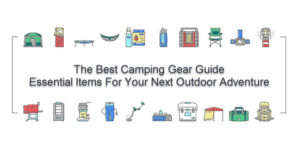Choosing a sleeping bag is an essential part of planning any camping adventure. A good quality sleeping bag can make all the difference between having a comfortable and enjoyable trip or being uncomfortably cold throughout your stay. In this guide, we will cover everything you need to know about choosing the best sleeping bag for your next outdoor camping experience.
Best Sleeping Bags for Camping Adventures
There are many different types of sleeping bags available on the market today, each with their own unique features and benefits. Here are some of the most popular options:
1. Mummy-style sleeping bags – These are by far the most common type of sleeping bag and offer excellent insulation properties due to their tapered shape. They typically come in two styles; rectangular shaped bags that have a mummy-like fit or semi-rectangular bags which provide more room to move around inside.
2. Rectangular sleeping bags – These bags are wider than they are long and tend to be less bulky than traditional mummy style bags. This makes them ideal for people who prefer not to feel constricted while sleeping. However, these bags may not be as warm as other models since they don’t compress body heat like a mummy bag does.
3. Double sleeping bags – If you plan on sharing a tent with someone else during your camping trip, then a double sleeping bag might be just what you need. These bags are designed to accommodate two people comfortably without sacrificing too much space.
Sleeping Bag Reviews and Buying Guide
When it comes to buying a new sleeping bag, there are several factors to consider such as temperature rating, fill power, shell material, weight, size, price etc. Let’s take a closer look at each factor:
Temperature Rating – The temperature rating of a sleeping bag refers to how low it can keep you warm under certain conditions. It is usually measured using a system called EN ratings, where higher numbers indicate colder temperatures. For example, a sleeping bag rated to minus 5 degrees Celsius would be suitable for use in moderately cold weather conditions.
Fill Power – Fill power is another important consideration when selecting a sleeping bag. It measures the loftiness or fluffiness of down feathers used in the filling of the bag. Higher fill powers mean better insulation capabilities and warmer nights. Synthetic fibers also have fill power ratings but aren’t quite as effective as natural down.
Shell Material – The outer shell of a sleeping bag plays a crucial role in determining its durability and water resistance. Some common materials include nylon, polyester, and cotton. Nylon tends to be lightweight yet strong enough to handle rough terrain, making it a great choice for hiking and backpacking trips. Polyester blends are often more affordable and breathable, making them perfect for summer camping trips. Cotton is not recommended for outdoor gear because it absorbs moisture easily and doesn’t dry quickly.
Weight – Weight is another critical aspect to consider when purchasing a sleeping bag. Lighter bags are generally easier to carry and pack away into smaller spaces. But remember, lighter bags sometimes sacrifice warmth and durability.
Size – The size of a sleeping bag should match the height and width of the person who will be using it. Make sure to measure yourself accurately before ordering one online. Also, check if the bag has extra room for movement or layering clothing.
Price – As with anything, you get what you pay for. Cheap sleeping bags may lack key features such as high-quality insulation or durable fabrics. On the flip side, expensive bags may have advanced technologies and luxurious amenities that cater to specific needs.
Considerations When Choosing a Sleeping Bag
Before deciding on a particular model, here are some additional things to consider:
Climate – Think about where you will be camping and what kind of climate you will encounter. For instance, if you plan on going skiing, you will require a heavier duty sleeping bag compared to a beach vacation.
Seasonality – Different seasons call for varying levels of warmth. Winter sleeping bags tend to be bulkier and thicker whereas summer ones are made from lighter materials and designed to breathe better.
Comfort Level – Consider whether you want a soft and cozy bag or something more rugged and durable. Additionally, think about whether you prefer a top-loading or bottom-loading design. Top-loaders allow easy access to your gear stored in the foot box, while bottom loaders are simpler to enter and exit.

Quality Matters

In conclusion, choosing the right sleeping bag for your camping adventure requires careful consideration of various factors including temperature rating, fill power, shell material, weight, size, price, seasonality, climatic condition, comfort level, and personal preference. Remember, investing in a high-quality sleeping bag now could save you discomfort later on.

